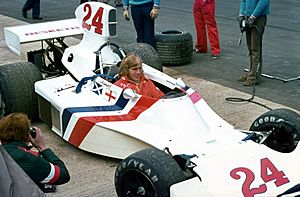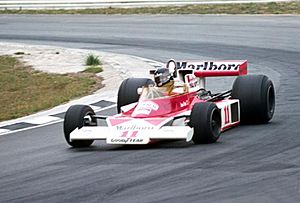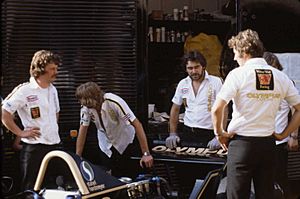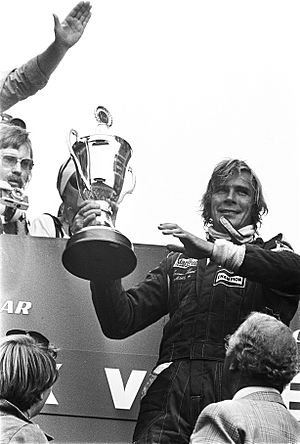James Hunt facts for kids

Hunt in 1977
|
|
| Born | 29 August 1947 Belmont, Surrey, England |
|---|---|
| Died | 15 June 1993 (aged 45) Wimbledon, London, England |
| Formula One World Championship career | |
| Nationality | |
| Active years | 1973–1979 |
| Teams | Hesketh, McLaren, Wolf |
| Entries | 93 (92 starts) |
| Championships | 1 (1976) |
| Wins | 10 |
| Podiums | 23 |
| Career points | 179 |
| Pole positions | 14 |
| Fastest laps | 8 |
| First entry | 1973 Monaco Grand Prix |
| First win | 1975 Dutch Grand Prix |
| Last win | 1977 Japanese Grand Prix |
| Last entry | 1979 Monaco Grand Prix |
James Simon Wallis Hunt (born August 29, 1947 – died June 15, 1993) was a British racing driver. He became a Formula One World Champion in 1976. After he stopped racing in 1979, Hunt worked as a sports commentator and also as a businessman.
James Hunt started his racing journey in touring car racing. He then moved up to Formula Three racing. There, the Hesketh Racing team noticed him and took him under their wing. Hunt was known for his exciting and sometimes risky driving. This earned him the nickname "Hunt the Shunt," because "shunt" means "crash" in British motor racing.
He joined Formula One in 1973 with the Hesketh team. He won races for Hesketh before joining the McLaren team in late 1975. In his first year with McLaren, Hunt won the 1976 World Drivers' Championship. He stayed with McLaren for two more years but had less success. He then moved to the Wolf team in early 1979. After several races where he didn't finish, Hunt decided to retire from racing in the middle of the 1979 season.
After retiring from motor racing, he became a well-known commentator for the BBC. He passed away at the age of 45 due to a heart attack.
Contents
Growing Up and Early Life
James Hunt was born in Belmont, Surrey, England. He was the second of six children. His father, Wallis Hunt, was a stockbroker. The family lived in different places in Surrey and London as James grew up. He went to Westerleigh Preparatory School and later Wellington College.
James first learned to drive a tractor on a farm in Wales during a family holiday. He found changing gears difficult at first. He passed his driving test just one week after his seventeenth birthday. He later said that his life "really began" at that moment. In 1965, he also started skiing in Scotland.
His interest in motor racing began when he visited Silverstone with a friend whose brother raced Minis. Seeing the race made him obsessed with the sport.
Starting His Racing Career
Mini Racing Days
Hunt's racing career began with a racing Mini car. He tried to enter a race at the Snetterton Circuit in Norfolk. However, race officials stopped him because his Mini had many illegal changes. This made Hunt and his teammate, Justin Fry, very upset.
Hunt later earned money working at a telephone company to pay for three more races. At this point, Fry left the team because of the car problems.
Moving to Formula Ford
In 1968, Hunt moved up to Formula Ford. He bought a Russell-Alexis Mark 14 car using a special payment plan. In his first race at Snetterton, his engine was not set correctly, making his car less powerful. Still, he managed to finish fifth. Hunt won his first race at Lydden Hill. He also set a new lap record at the Brands Hatch short circuit.
Racing in Formula Three

In 1969, James Hunt raced in Formula Three. He had money from a sponsor called Gowrings of Reading. He won several races and often finished in high positions. Because of his promising career, the British Guild of Motoring Writers gave him a special Grovewood Award.
In 1970, Hunt had a famous crash with another driver, Dave Morgan. They were battling for second place in a race at Crystal Palace. On the last lap, their cars crashed. Hunt got out of his car and angrily pushed Morgan to the ground. Race officials were very unhappy about this. After an investigation, Hunt was cleared, but Morgan's racing license was suspended for a year.
Hunt continued his career with the March team in 1972. His first race saw him finish third, but he was disqualified because his engine was not allowed. He had some mechanical problems with his cars that year. Later, he was dropped from the March team.
Formula One Adventures
1973–1975: The Hesketh Years
- 1973
- Starting Strong
The Hesketh team bought a March 731 car and improved it. At first, other teams didn't take Hesketh seriously. They thought the team was just there to have fun. But the Hesketh car was very fast. Their best result was second place at the 1973 United States Grand Prix. After the season, Hunt received the Campbell Trophy for being the best British driver in Formula One.
- 1974
- Building Their Own Car
For 1974, Hesketh Racing built their own car, the Hesketh 308. Hunt found it more stable than the previous car. He was paid £15,000. The Hesketh team became popular because their car had no sponsor logos. They also had a fun, carefree attitude, but their engineers were very skilled. Hunt's best moment this year was winning a non-championship race at Silverstone.
- 1975
- First Win and a Big Move
Hunt had some tough races in 1975 with mechanical problems. But he got his first Formula One win at the 1975 Dutch Grand Prix in Zandvoort. He finished fourth in the championship that year. However, Lord Hesketh, the team owner, ran out of money.
With the 1976 season approaching, Hunt needed a new team. Luckily, Emerson Fittipaldi left McLaren. McLaren then signed Hunt for $200,000.
1976–1978: The McLaren Years
- 1976
- World Champion!
The 1976 season was one of the most exciting in Formula One history. Many people wondered if Hunt could win the championship. But he proved them wrong right away by getting pole position in the first race in Brazil. He won six races that year in his McLaren M23. However, his main rival, Niki Lauda, had a big points lead because his car was more reliable.
Hunt's first win of 1976 was at the 1976 Spanish Grand Prix. But he was disqualified because his car was too wide. The win was later given back to him after an appeal. This showed how dramatic the season would be. At the 1976 British Grand Prix, Hunt was involved in a crash at the start. The race was stopped and restarted. Hunt won the restarted race, but his victory was later taken away by officials.
Lauda was seriously injured in a crash at the 1976 German Grand Prix at the Nürburgring. Hunt won that race easily after it was restarted. Lauda's injuries kept him out of the next two races. This allowed Hunt to catch up in the championship. Hunt won at Zandvoort and then at the Canadian Grand Prix.
The final race was in Japan. Hunt was only three points behind Lauda. The weather was terrible, with heavy rain. Lauda retired early because he couldn't blink properly due to his injuries. Hunt led most of the race but then had a flat tire and a slow pit stop. Despite the problems, he finished third. This was enough for him to win the World Championship by just one point! James Hunt was the last British Formula One champion until Nigel Mansell in 1992.
- 1977
- A Tougher Season
The 1977 season didn't start well for Hunt. His new car, the McLaren M26, had problems early on. Other drivers like Niki Lauda, Mario Andretti, and Jody Scheckter gained a big lead in the championship. Towards the end of the year, Hunt and the McLaren M26 became faster. Hunt won at Silverstone and then again at Watkins Glen in the United States. He finished fifth in the World Drivers' Championship.
- 1978
- Challenges and Sadness
Before the 1978 season, Hunt hoped to win another world championship. However, he only scored eight points that year. McLaren's car was not as good as others, especially the Lotus 79. Hunt's motivation was low.
Hunt was deeply affected by the fatal crash of his friend, Ronnie Peterson, at the 1978 Italian Grand Prix. There was a big accident at the start of the race. Peterson's car caught fire. Hunt, along with other drivers, helped rescue Peterson from the car. Sadly, Peterson died the next day in the hospital. Hunt blamed another driver, Riccardo Patrese, for the accident for many years. However, later video evidence showed that Patrese was not at fault.
1979: Retiring from Racing
For 1979, Hunt decided to leave McLaren. He joined Walter Wolf Racing. He hoped to find a team atmosphere similar to his early days at Hesketh. He had high hopes to win races and compete for the championship. However, the team's car was not competitive. Hunt quickly lost his excitement for racing. He watched as Jody Scheckter won the World Drivers' Championship that year.
In the first race in Argentina, his car was hard to drive. In the race, he retired due to an electrical problem. He also retired in Brazil due to steering issues. His brakes failed during qualifying in South Africa. He finished 8th in that race.
After failing to finish the 1979 Monaco Grand Prix, Hunt announced his immediate retirement from Formula One on June 8, 1979. He said his heart was no longer in it. He was replaced by future world champion Keke Rosberg. Even after retiring, he continued to work for his sponsors, Marlboro and Olympus.
Life After Racing (1979–1993)
Almost a Comeback
In 1980, Hunt almost returned to racing with McLaren. He asked for $1 million for one race. This chance came because their regular driver, Alain Prost, had broken his wrist. However, negotiations ended when Hunt broke his leg while skiing. In 1982, Bernie Ecclestone, who owned the Brabham team, offered Hunt a large salary to race, but Hunt turned it down.
Other Activities
Hunt appeared briefly in a 1979 British comedy film called The Plank. He also appeared in a TV advertisement for Texaco. He was hired by John Hogan to advise and teach young drivers sponsored by Marlboro. He helped them with racing strategies and their approach to the sport. Mika Häkkinen, a future Formula One champion, had many discussions with Hunt about racing and life.
Family and Friends
Early in their careers, James Hunt and Niki Lauda were good friends. Lauda sometimes stayed at Hunt's apartment when he needed a place to sleep. Lauda described Hunt as an "open, honest to God pal." Lauda admired Hunt's speed, and Hunt admired Lauda's careful thinking.
Hunt was also good friends with Jody Scheckter. Hunt gave Scheckter the nickname "Fletcher" after a character in a book. Another close friend was Ronnie Peterson. Peterson was quiet, while Hunt was outgoing, but their different personalities made them very close. Hunt also helped Gilles Villeneuve get his start in Formula One.
James Hunt had two sons, Tom and Freddie, with his second wife, Sarah Lomax. His son Freddie is also a racing driver. Hunt later met Helen Dyson in 1989. She was 18 years younger than him. This relationship brought new happiness to Hunt's life. The day before he passed away, Hunt proposed to Helen over the phone.
Passing Away
James Hunt died in his sleep on the morning of June 15, 1993. He had a heart attack at his home in Wimbledon. He was 45 years old.
At his funeral, his father and brothers were among the pallbearers. He was cremated at Putney Vale Crematorium. After the service, mourners opened a special bottle of wine that James had given his father years before.
His Legacy
Hunt was known for being a very fast driver with an exciting driving style. He was sometimes called Hunt the Shunt because of his spectacular crashes. However, he wasn't necessarily more accident-prone than other drivers. John Hogan, a racing expert, said Hunt understood what it truly takes to be a racing driver. Niki Lauda said, "We were big rivals... but I respected him because you could drive next to him—2 centimetres, wheel-by-wheel, for 300 kilometres or more—and nothing would happen. He was a real top driver."
After winning the world championship in 1976, Hunt inspired many young people to get into motor racing. He also helped guide new drivers. In 2007, Formula One driver Kimi Räikkönen entered and won a snowmobile race using the name James Hunt. Räikkönen has often said he admires the lifestyle of 1970s race car drivers like Hunt. In 2014, James Hunt was added to the Motor Sport Hall of Fame.
His Helmet
Hunt's racing helmet was black with blue, yellow, and red stripes on the sides. It also had his name in bold letters and space for his sponsor, Goodyear. The blue, yellow, and red stripes were the colors of his school, Wellington College. In 2012 and 2013, Kimi Räikkönen wore a helmet painted like James Hunt's at the Monaco Grand Prix as a tribute.
Images for kids
See also
 In Spanish: James Hunt para niños
In Spanish: James Hunt para niños
- Hunt–Lauda rivalry












